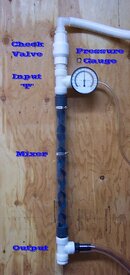I built a couple of skiks for use with my Bauer Capitano and a Kidde portable. They are two inch PVC, nothing fancy, just what I could find at Home Depot. I cut a small piece of 3/16 brake line and threaded it 10-32. The PVC pipe was drilled and tapped to take this home made barb. The intake of the stik is a PVC 2 inch cap with holes drilled. Intake air is filtered with a 2 inch felt pad normally used with air compressor filters. The felt is fitted into the round nose cap without glue. When the cap/filter pad is pressed on the pipe the felt will not shift or distort, it fits perfectly. I also made a second intake with a small engine filter. The filter is a small cage with a pipe fitting on bottom. This is screwed into a PVC cap and pressed on the PVC pipe. Inside where the pipe penetrates the cap, I glued a non return valve from a two hose regulator. I thought this might be of some use when pumping buoyant helium but who knows. It looks cool. I stuffed some Gottschalk stainless steel sponges (scouring pads) inside the PVC pipe. On the bottom, an elbow was fitted. This was capped and drilled and tapped 1/2 inch NPT. Into this was fitted a PVC coupler which is a 50 cent piece of plastic threaded 1/2 inch male/ 1/2 inch female. The diameter of this piece is 1 inch, perfect for running a clear plastic hose from the fitting to the Bauer compressor. The elbow on the bottom of the PVC pipe makes for easy, lateral routing of the hose and serves as a trap for any particles left inside the stik. The output of the stik goes through the hose and into the Bauer intake housing where it is filtered before being inhaled by the machine. On the other stik, which feeds a portable compressor with no integral filter, a foam pad is inserted near the bottom of the stik and held in place with a spring formed from a SS hose clamp. This prevents any particles getting through. On both stiks, holes were drilled and tapped near the bottom for the O2 sensor. It takes about an hour to make a stik, not including shopping for the bits and pieces. Generally, I used whatever stuff I had on hand and shaped them to fit. For example, the foam pad was cut from seat cushion foam using a hole saw. I don't believe it serves any purpose to go artsy fartsy on these stiks, at least not those for personal use. My mixes generally end up within 0.2 percent accuracy. I found that my compressor does not produce consistent output throughout the pressure range. This is due to age and blowby. So, when pressures exceed 3000 psi it is necessary to dial back the O2 a bit. For a short time, I used a bleed from the compressor to check O2 at the point of delivery but after a short learning curve I disconnected it. I don't need it to get accurate mix.





